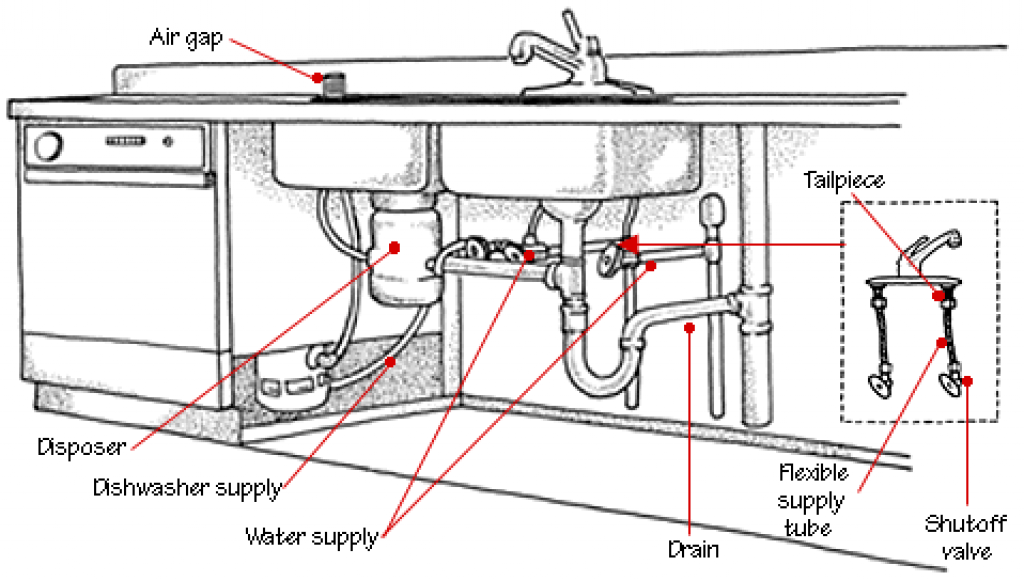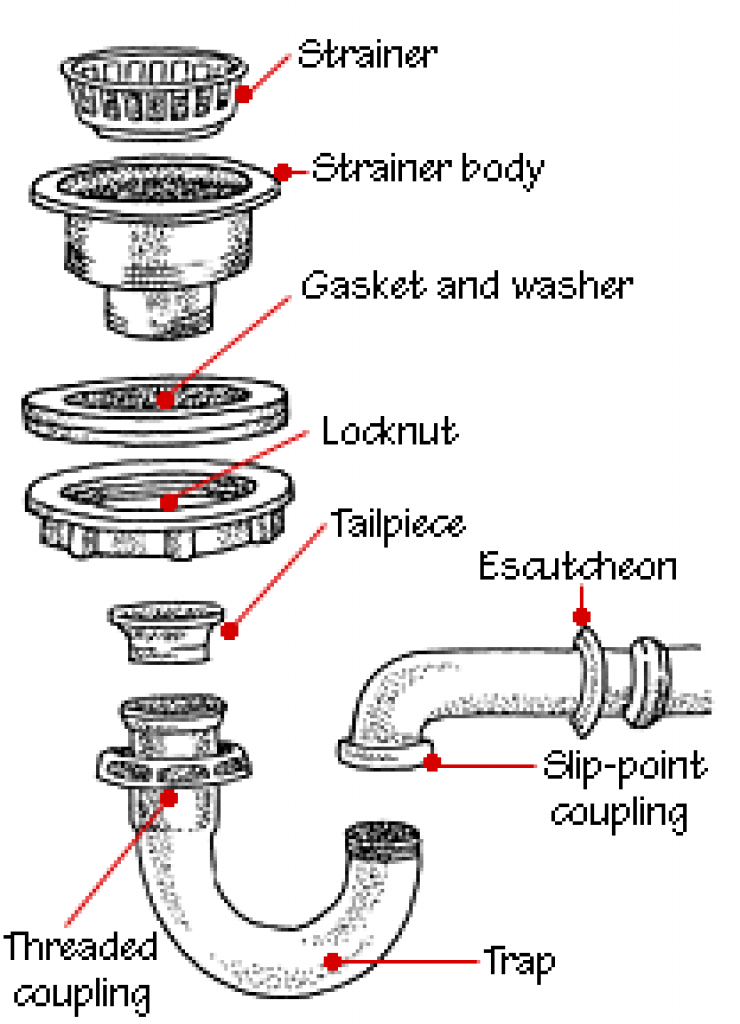The kitchen and bathroom sinks are connected both to the home’s water supply system, which provides the faucets and the drain-waste-vent system (DWV) for drains. Kitchen and bathroom sinks are designed to operate similarly, but they differ in how many fixtures they can connect with. A kitchen sink is typically hooked up for things like water filters or dishwashers, while a bathroom model may feature one faucet attachment at most since there’s no need for extra gadgets on hand.

Do you ever wonder why your sink drains are clogged with food particles? It is because of the plumbing behind it. This blog post will explain how to sink and drain plumbing works.
Recommended Reading: Unclogging a Double Kitchen Sink – 6 Easy Steps
What is a Sink and Drain Plumbing System?
A sink and drain plumbing system is a series of pipes, valves, fixtures, and other components that work together to provide water for the kitchen. A sink is used for washing dishes or hands while a drain catches all your dirty water, so it doesn’t go down the pipe into your home’s septic tank. The pipes are usually made out of copper but can be plastic PVC as well.

How a Sink Drain Works?
In almost every home without a sink drain, there would always be a bad odor coming from the sink. Although it is unlikely that you will come across one in school or work as they are not as commonly used as faucets because of their connection to the sewage system, it also serves an essential purpose: to dispose or convey wastes and water into the drainage system. The following discussion gives you a detailed insight into how sink drains work and why they are necessary for every household.
Read: How to Plumb a 3 Compartment Sink – 6 Easy-to-Follow Steps
What does a drain do?
A sink drain is used by people to quickly dispose of water and wet wastes such as food scraps and dirty dishwater, allowing the waste products to flow down the drain to the sewage system. This is possible because of the pull of gravity that aids in draining water and wastes down your kitchen or bathroom sink.
How does it work?
A sink drain works by allowing the flow of water into it when it goes directly into your sewer system, either through direct connection or through a septic tank. The waste products are carried along with the water and flushed out of your home through the sewer system.

Read: Top 8 Best Copper Kitchen Sinks For Stylish, Enduring Designs
What Types of Sink Drains Are There?

There are mainly two main types of sink drains that you can see in almost every household, which are the P-trap and S-trap, commonly known as P and S-traps.
The P-trap is used to block sewer gas from coming into your home and is commonly attached below the sink drain. It consists of a 90-degree bend installed at an angle to prevent any solids or gases from passing through the opening. This leads down into the drainpipe, which allows waste products to pass through.
The S-trap is a loop of pipe that does not have a bend but instead has a U-shaped opening that allows water to flow freely from the sink basin and pass it along the waste pipe. Therefore, this type of drain is often used in household sinks to prevent any bad odors or fumes from coming into the room. It will simply attach by placing it underneath the sink drain, often supported by metal straps.
Finally, there are also other types of sink drains that you can find in your household appliance or plumbing stores that include a basket-style drain, double offset drain, and center outlet drain.

Read: How to Clean a Copper Sink – Complete Copper Sink Cleaning and Care
What Is a Sink Trap?
A sink trap is a device in your plumbing system that prevents sewer gas from coming up through the drain. Unfortunately, If you have a terrible smell coming out of the kitchen sink, it’s likely because your sink trap needs to be cleaned or replaced.
The most common reason for this problem is that food debris gets stuck in the pipe and creates an obstruction. You may use a cleanout plug to remove this blockage from the trap. However, if that doesn’t work, you may need to replace your entire setup with a new one. It will get rid of any bacteria buildup and prevent future problems like clogs and backups.
Advantages of a Well-functioning Sink and Drain Plumbing System
1. A well-functioning sink and drain plumbing system are vital for good hygiene.
2. It can also prevent odors from coming up through the drains.
3. The pipes are less likely to clog, which will cause your water bill to go down.
4. You’ll be able to use more water in your home without worrying about flooding or leaks.
5. Your pipes will last longer when you have a well-functioning sink and drain the plumbing system.
6. You’ll have much less risk of getting an infection if you have a properly functioning sink and drainage plumbing system.
Recommended Reading: Best Under Sink Water Filter of 2021 – Complete Buying Guide & Reviews
Disadvantages of a Poorly Functioning Sink and Drain Plumbing System
1. Poorly functioning plumbing can lead to a buildup of dangerous bacteria.
2. A poorly functioning sink and drain system will not function as well as it should, which can lead to clogs that are very difficult or impossible to remove.
3. A poorly functioning sink and drain system is more prone to leaking due to poor sealing between the pipes.
4. The waste from your kitchen sink may overflow into other parts of your home if you have a leakage in the plumbing system.
5. There is a higher risk for mold growth when there is standing water in the pipes because this provides an ideal environment for mold spores.
6. If you have a septic tank, then leaks in your plumbing system could result in sewage overflowing onto your property or even into the street outside your house.
7) Leaks in any part of your plumbing system can cause damage that might be expensive to repair later on down the line.
Related: How to Fix a Leaky Kitchen Sink – Step by Step Guide
How do You Maintain a Sink Drain?
It would be best to regularly clean out your sink and drain with a plunger or a rag to remove any food particles that might stop inside it. In order to prevent a sink drain from leaking or rusting, you can make use of a rubber or plastic stopper to plug the drain and avoid any waste products from entering it. Moreover, you should also consider checking your regular household pipes now and then to repair any issue or damage that might come up along the way, such as leaks and corrosion.






